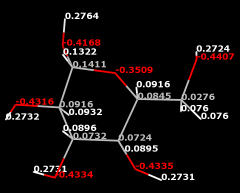 Add Charge assigns atomic partial charges and Amber/GAFF atom types
as the attributes
charge and gaffType, respectively.
Add Charge assigns atomic partial charges and Amber/GAFF atom types
as the attributes
charge and gaffType, respectively.
See also: AddH, Dock Prep, Minimize Structure, Add Ions, Write Prmtop
There are several ways to start Add Charge, a tool in the Structure Analysis and Structure Editing categories. Add Charge is also implemented as the command addcharge.
Models to process can be chosen from the list with the left mouse button. Ctrl-click toggles the status of an individual model. To choose a block of models without dragging, click on the first (or last) and then Shift-click on the last (or first) in the desired block.
Charge model indicates the parameters to use for standard residues (details):
AddH will be called as needed to add hydrogens. Potentially ambiguous or rare protonation states, especially in binding sites and nonstandard residues, should be verified and corrected before charges are assigned. For example, extra hydrogens could be deleted, or atom types could be edited (before hydrogen addition) with setattr or Build Structure.
If there are any nonstandard residues, a dialog will appear for specifying the net charge of each nonstandard residue and which charge calculation method should be used (details).
If a nucleic acid chain has a 5' terminal phosphate, the user will be asked whether this group should be deleted; otherwise, its atoms will be assigned charges of zero (the charge sets lack parameters for 5' phosphates).
A warning will appear if the name of any atom in a standard residue is not recognized or a model's net charge is not an integer; details will be reported in the Reply Log. Cases of unrecognized atoms in standard residues and/or incorrect net charges should be examined and resolved. Note that chain-terminal nucleotide residues will normally have non-integral charges, but the 5' and 3' charges sum to an integer.
Atoms in standard residues (water, standard amino acids, standard nucleic acids, and a few common variants and capping groups) are assigned charges and atom types taken from Amber parameter files. Charge model corresponds to force field version (see the Amber documentation for further details):
W.D. Cornell, P. Cieplak, C.I. Bayly, I.R. Gould, K.M. Merz, Jr., D.M. Ferguson, D.C. Spellmeyer, T. Fox, J.W. Caldwell, and P.A. Kollman, "A Second Generation Force Field for the Simulation of Proteins, Nucleic Acids, and Organic Molecules" J Am Chem Soc 117:5179 (1995).
A. Pérez, I. Marchán, D. Svozil, J. Sponer, T.E. Cheatham III, C.A. Laughton, and M. Orozco, "Refinement of the AMBER force field for nucleic acids: improving the description of α/γ conformers" Biophys J 92:3817 (2007).
P. Cieplak, J. Caldwell, and P. Kollman, "Molecular mechanical models for organic and biological systems going beyond the atom centered two body additive approximation" J Comput Chem 22:1048 (2001).
Z.X. Wang, W. Zhang, C. Wu, H. Lei, P. Cieplak, and Y. Duan, "Strike a balance: optimization of backbone torsion parameters of AMBER polarizable force field for simulations of proteins and peptides" J Comput Chem 27:781 (2006).
L. Yang, C.H. Tan, M.J. Hsieh, J. Wang, Y. Duan, P. Cieplak, J. Caldwell, P.A. Kollman, and R. Luo, "New-generation amber united-atom force field" J Phys Chem B 110:13166 (2006).This "united-atom" force field treats amino acid sidechain aliphatic hydrogens as if they were collapsed onto the corresponding carbons. All nucleic acid hydrogens and amino acid backbone, polar, and aromatic hydrogens are still explicit. This option generates warning messages about the unrecognized and thus uncharged aliphatic hydrogens, which can be safely ignored.
Y. Duan, C. Wu, S. Chowdhury, M.C. Lee, G. Xiong, W. Zhang, R. Yang, P. Cieplak, R. Luo, T. Lee, J. Caldwell, J. Wang, and P. Kollman, "A point-charge force field for molecular mechanics simulations of proteins based on condensed-phase quantum mechanical calculations" J Comput Chem 24:1999 (2003).
Water charges correspond to the TIP3P model:
W.L. Jorgensen, J. Chandrasekhar, and J.D. Madura, "Comparison of simple potential functions for simulating liquid water" J Chem Phys 79:926 (1983).Note different solvent charge sets can be obtained using Solvate. Charges previously assigned to solvent atoms by Solvate are not overwritten by Add Charge.
Cases of unrecognized atoms in standard residues and/or incorrect net charges should be examined and resolved. Approaches include:
Charges and GAFF atom types in nonstandard residues (any not classified as standard) are determined using Amber's Antechamber module, which is included with Chimera.
A dialog will appear for specifying the net charge of each nonstandard residue and which charge calculation method should be used:
While both methods are much faster than ab initio calculations, the Gasteiger method is the faster and more approximate of the two. Regardless of which method is chosen, residues that are monatomic ions will simply be assigned their net charges.
Publications involving
Antechamber use should cite:
J. Wang, W. Wang, P.A. Kollman, and D.A. Case, "Automatic atom type and
bond type perception in molecular mechanical calculations"
J Mol Graph Model 25:247 (2006).
GAFF atom types and associated parameters are described
online
and in:
J. Wang, R.M. Wolf, J.W. Caldwell, P.A. Kollman, and D.A. Case, "Development and testing of a general amber force field." J Comput Chem 25:1157 (2004).
Additional sources of charges and other parameters include: